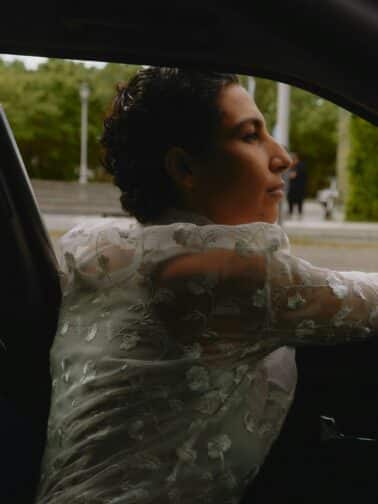What I want to talk to you about today isn’t exactly one of the “sexiest” topics out there in the whole personal growth world, but, as a psychotherapist, I actually think it’s one of the *single* most important topics we could possibly talk about. It is such a big and important topic that I created a whole course centered around it.
It’s a topic that impacts every area of your life daily, hourly, constantly. From your romantic relationships to your career, from your finances to holidays with your in-laws, today’s topic is … drumroll please…
BOUNDARIES.
This all-important B-word impacts every area of your life and if you weren’t taught and modeled good, functional boundaries growing up or if you’re in relationship with people who can’t or don’t respect your boundaries, then how you currently understand and hold your own personal boundaries may be negatively and pervasively impacting your life (not to mention the lives of your loved ones).
So in today’s blog post, I want to define what they actually are, give examples of good and unhealthy ones (illustrating how they impact nearly every area of our lives), and talk about what it takes to (re)learn and practice something different if you suspect you may have unhealthy boundaries in some areas (hint: it’s never too late to change this!).
So What Exactly *Are* Boundaries?
I’m sure most of us, when quizzed, will be able to somewhat know and understand what they generally are. A sign that says “Do Not Enter”, a fence that separates your neighbor’s property from yours, city, state, and country lines, hours of operation for a business, all of these are all well-understood (and fairly obvious) examples of spatial and logistical boundaries that most of us more or less accept, respect, and understand.
But when it comes to our personal lives, boundaries become much more subtle, nuanced, and complex which is why my favorite definition of boundaries in the therapeutic context comes from educator and clinical consultant, Pia Mellody, a pioneer in the field of recovery, codependence, and the effects of abuse on childhood development. Her definition states that:
“Boundary systems are invisible and symbolic “fences” that have three purposes: 1. to keep people from coming into our space and abusing us 2. to keep us from going into the space of others and abusing them 3. to give each of us a way to embody our sense of “who we are.”
She continues by saying that these are external and internal, and fall across four major categories: physical, sexual, emotional, and spiritual (and in some lectures of hers I’ve also heard her refer to “intellectual” boundaries – a category I’ll also be talking about in today’s post).
These internal and external boundaries across all categories are not static, they’re dynamic – meaning they constantly change depending on the contexts we find ourselves in during the day. Not only that, but we’re also responsible for not only knowing and holding our own good, functional boundaries, but also responsible for sensing and respecting (and not violating!) others’.
What's Running Your Life?
The invisible patterns you can’t outwork…
Your LinkedIn profile tells one story. Your 3 AM thoughts tell another. If vacation makes you anxious, if praise feels hollow, if you’re planning your next move before finishing the current one—you’re not alone. And you’re *not* broken.
This quiz reveals the invisible patterns from childhood that keep you running. Why enough is never enough. Why success doesn’t equal satisfaction. Why rest feels like risk.
Five minutes to understand what’s really underneath that exhausting, constant drive.
Are you getting a sense of how big and nuanced a topic this is and how much this can impact your life? If not, these following examples may help illustrate just how important and pervasive good, functional boundaries can be.
Examples of Good Boundaries vs. Poor Boundaries:
Physical:
Physical boundaries are an example of an external boundary. Meaning they involve literal external touch or contact from other sources that we either allow or block physically according to what we feel comfortable with.
Examples of poor physical boundaries might include:
- Letting someone stand way too close to you on the subway even though they make your skin crawl and there’s clearly plenty of room for them or you to move elsewhere (i.e.: Your physical boundary is being crossed and yet you’re not vocalizing it.).
- Insisting your kid go on over and hug someone when they don’t want to (i.e.: You’re violating your child’s physical boundary by insisting they touch someone that they don’t want to.).
Examples of good functional physical boundaries might include:
- Asking someone’s permission before you hug them (i.e.: Checking in with them to see if they’re available for physical contact at the moment is respecting someone else’s physical boundary.).
- Not attending a family reunion because you feel unsafe or uncomfortable with someone who will also be attending (i.e.: Keeping yourself safe by physically removing yourself from the proximity of someone else is a way of protecting your own physical boundary.).
Sexual:
These are, again, an example of an external boundary involving literal contact from other sources that we either allow or block physically according to what we feel comfortable with.
Examples of poor sexual boundaries might include:
- Insisting, cajoling, or shaming someone into have sex when they’re not in the mood. (i.e.: You’re violating the external sexual boundary of another person to satisfy your own needs by insisting they have sex when they don’t want to.).
- Doing something sexually with your partner that you simply don’t want to do but are afraid to say no to (i.e.: You’re crossing your own sexual boundary by not holding and advocating or talking about your resistance with the other person.).
Examples of good sexual boundaries might include:
- Negotiating when, where, and how you and your honey want to have sex (i.e.: You’re honoring the boundary of another person by checking in with them about what they are and are not available for.).
- Insisting on using a condom when you’re hooking up with someone (i.e.: You’re protecting your own body and sexual boundaries by insisting on safe sexual practices.).
Emotional:
These are an example of an internal boundary. Meaning they involve data or input from inside ourselves or from other sources that we either allow, process or block internally according to what we feel comfortable with.
Examples of poor emotional boundaries might include:
- Shaming or blaming someone for not acting in a way that you find preferable (i.e.: You’re violating the emotional boundary of another person by insisting implicitly or explicitly they feel a way they don’t.).
- Ignoring your own intuition/gut/strong feelings about not wanting to date someone but not speaking up about it for fear of the consequences (i.e.: You’re crossing your own emotional boundaries by not naming, honoring and following through on how you feel.).
Examples of good emotional boundaries might include:
- Standing up for yourself when you feel yourself being shamed or criticized and asking that the other person treat you more respectfully (i.e.: You’re holding your own emotional boundary and speaking up about it.).
- Managing your own anxiety and not lashing out at your partner to release your own emotional pain (i.e.: You’re respecting the emotional boundaries of the other person by taking responsibility for your own feelings.).
Spiritual/Intellectual:
Spiritual and intellectual boundaries are additional examples of internal ones. Meaning they involve data or input from inside ourselves or from other sources that we either allow, process or block internally according to what we feel comfortable with.
Examples of poor spiritual/intellectual boundaries might include:
- Not trusting your own sense of spirituality and ethics and instead going with what some other person or organization insists is “right” (i.e.: You’re ignoring your own internal spiritual boundary.).
- Lying to your partner and even “gaslighting” them into believing something that they sense isn’t true. (i.e.: You’re violating the intellectual boundary of another person by insisting your reality is truth and theirs isn’t.).
Examples of good spiritual/intellectual boundaries might include:
- Honoring your own values and beliefs around the holidays instead of “buying into” what someone else thinks should be so (i.e.: You’re respecting your own.).
- Admitting when you don’t know a fact or figure to your spouse or partner and being willing to Google it up or research it so that you can communicate accurate information (i.e.: You’re respecting the intellectual boundary of someone else by not falsifying information.).
Why Might You Have Poor Boundaries and What To Do To Improve Them.
In the examples I listed above, I barely scratched the surface of all the many ways boundaries who up in our lives and what poor examples of them might look like. There’s countless other examples of how poor boundaries may negatively impact our emotional, financial, relational, and professional lives and I’ll wager that if you’re reading this article you can think of a time or two when you either had your boundaries violated or maybe even violated someone else’s.
So why does this happen? Well for starters, we humans basically only do what we know. So if we’ve never been modeled good internal and external boundaries in our families-of-origin (and for children of alcoholic, dysfunctional or abusive families you can bet on the fact that this likely wasn’t modeled for you!), then how else can we know to do something different?
So if you’re reading this article thinking, “Oh crap. I know I have bad boundaries, now what do I do?” I want you to take a deep breath and to take hope. Boundaries are fluid, flexible, and, in my personal and professional experience, very much re-learnable through a few key steps. And remember: The reality with boundaries (as with all things in life) is that we’re aiming for progress here, not perfection.
Educate yourself further.
Check out the list of resources I provided below to start to better familiarize yourself with what boundaries are, how they show up in our lives, and what good ones may look like.
Experience something different in relationship.
In my experience, there’s no better way of re-learning good, functional boundaries than to be in relationship with someone who can both model this for you and who can also respect your own boundaries. If you have friends and loved ones in your life who can do this modeling for you, great! But for those of you who don’t, and even for those of you who do, I really, truly think that therapy is an incredible way to re-learn boundaries and to experience something different in relationship.
Wrapping up.
Of course, like with all things in life, we can imagine it took some time for your patterns of boundaries to develop, and it may take some time to relearn and practice something different, but if you’re interested and curious about learning how to improve your boundaries, start by checking out the resources I’ve listed below.
Now I’d love to hear from you:
What did you learn (or not learn) about boundaries growing up in your family? Is there a type of boundary that feels hard for you to understand and set? Can you share an example of how you personally learned to set better boundaries for yourself?
Leave a message in the comments below and I’ll be sure to respond.
Here’s to healing relational trauma and creating thriving lives on solid foundations.
Warmly,
Annie
Resources:
- Youtube Video: Pia Mellody on Developing Personal Boundaries.
- Facing Codependence by Pia Mellody*
*This is an affiliate link and any purchases made through this link will result in a small commission for me (at no extra cost for you).





